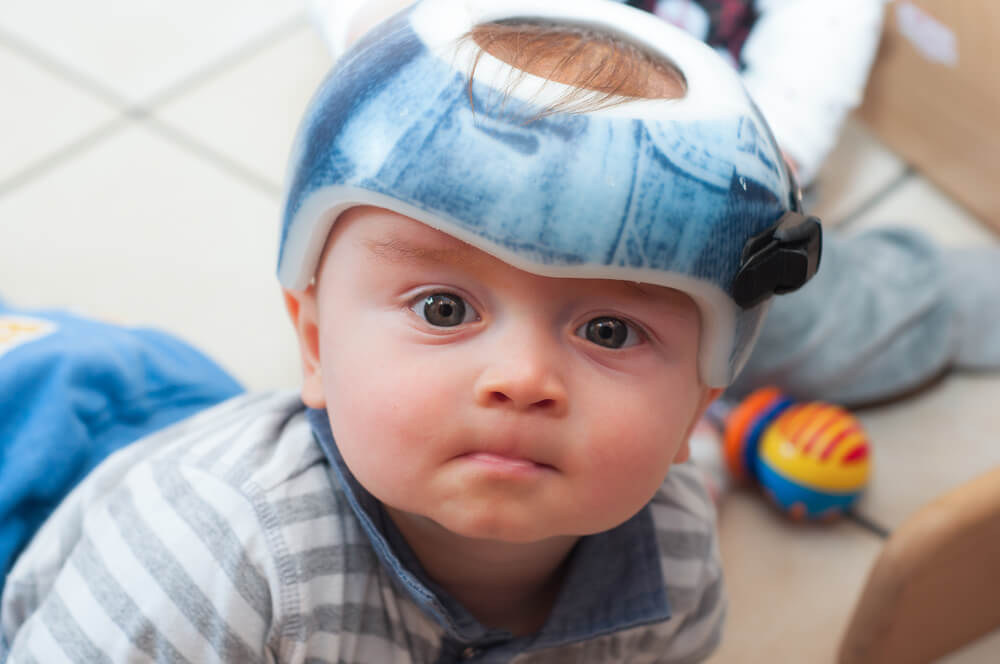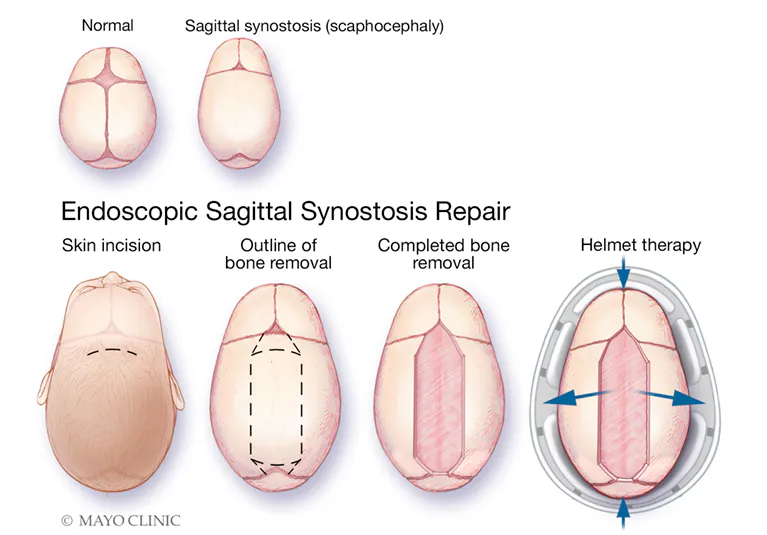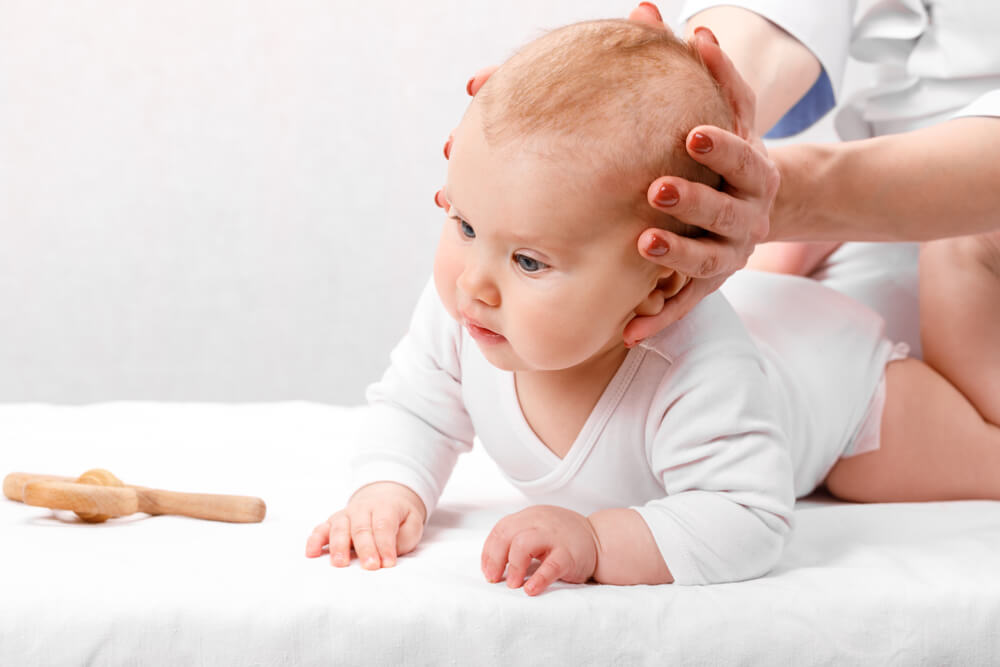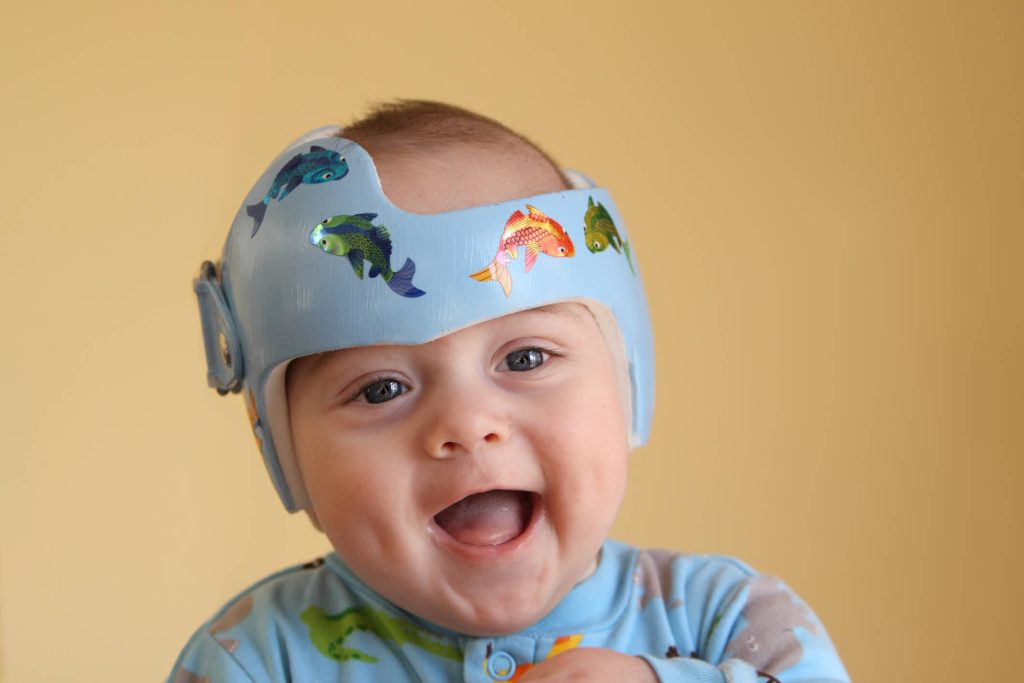The Whys and Hows of Baby Helmets: Insights for Worried Parents

Have you ever been sitting in a pediatrician’s office or at the grocery store and seen a baby wearing a helmet? You probably thought to yourself, why do babies wear helmets if they aren’t engaging in dangerous activities?
It’s quite common to see newborns don a baby helmet for flat heads, which helps their skulls grow and develop properly.
Contents:
- Why Do Babies Wear Helmets? Reasons and Causes
- Helmet Therapy
- Are Helmets Safe and Comfortable for Babies?
- Is Helmet Therapy the Only Treatment for a Child with a Positional Skull Deformity?
- FAQs
Why Do Babies Wear Helmets? Reasons and Causes

Elena Gavrilkina/Shutterstock.com
It isn’t uncommon to see babies wearing helmets during the first six months of their life. Known as helmet therapy, these specialized helmets aren’t simply for protecting your baby’s fragile head. It helps the malleable skull form properly in a round shape and prevents deformities.
When babies are born, their skulls are soft. This allows them to travel through the birth canal easily. These bones will form and harden over time.
Two common conditions require babies to wear helmets. These are known as Plagiocephaly and Craniosynostosis.
Plagiocephaly
Plagiocephaly, frequently referred to as flat head syndrome, affects approximately 50% of six-month-old infants.
This issue arises when a baby develops a flat spot on their head, or it becomes misshapen, typically due to looking in one direction while lying on their back.
It’s this preference, particularly during time spent sleeping, that can significantly influence the head shape.
Indeed, certain birth complications, premature birth, multiple births, and a condition called torticollis could also contribute to this problem. Early diagnosis and treatment are crucial to prevent the head shape from becoming drastically distorted.
Helmet therapy comes into play here. Helmets are specially designed for babies to gently direct growth towards the flatter areas of the skull, resolving the condition over time.
Repositioning techniques can also be employed along with helmet therapy to help mitigate the risk of plagiocephaly.

Credit: mayoclinic.org
Craniosynostosis
Craniosynostosis is known for its unique characteristic wherein a newborn’s skull bones fuse prematurely.
Normal brain development requires room to expand, which is obstructed due to this early fusion. As the brain persists with its natural growth course, it’s met with a constricted area. This then urges the head to mold into an atypical shape to accommodate the growing brain.
Craniosynostosis isn’t a random occurrence, as it can be part of a genetic syndrome. This syndrome leads to the premature fusing of the cranial bones, sometimes affecting not just the shape of the head but also potentially interfering with the baby’s neurological development.
Therefore, the baby helmet becomes a critical tool for encouraging a more regular head shape and supporting healthy brain development by providing the necessary room.
Helmet Therapy

Darren Brode/Shutterstock.com
Helmet therapy for babies is an effective, non-invasive approach to correcting head shape irregularities. By wearing a custom-fitted helmet, gentle pressure encourages natural skull growth and rectification in the flat areas, fostering a balanced spherically-shaped head over time.
What is Helmet Therapy and How Does It Work?
Helmet therapy uses a specially made corrective helmet to gently reshape your baby’s skull. This helmet acts as a mold, putting mild pressure on the flattened areas to encourage growth in those regions.
It’s a painless and comfortable treatment, designed uniquely for each child, typically initiated between the ages of four and six months.
The helmet stimulates natural growth, paving the way for a rounded skull, making this therapy a widely trusted approach in dealing with common head deformations in babies.
When Does Helmet Therapy Start?

Dmitry Naumov/Shutterstock.com
Helmet therapy typically begins when your baby is between 5 to 6 months old. This age is particularly vital as this is the stage when a baby’s skull is malleable, creating the perfect window to encourage and direct any necessary reshaping.
However, the start of this treatment may differ according to individual medical conditions or the doctor’s advice. An early start ensures effective results, as the helmet applies gentle but constant pressure to the flat areas of the skull to promote normal growth. Remember, always consult with your pediatrician to understand the best treatment timeline for your baby.
How Long Does Helmet Therapy Take to Work?
The duration of your little one’s helmet therapy can vary widely based on their specific condition and age when beginning treatment. However, on average, a typical helmet therapy program runs around three months.
The expectation during this period is for your baby to wear the helmet for nearly the whole day—a minimum of 23 hours, in fact. This prolonged, consistent contact grants the helmet the opportunity to perform its corrective purpose.
When is it Too Late for Helmet Therapy?

ARTYOORAN/Shutterstock.com
As your little one grows, around the 10-to-12-month mark, their skull becomes less flexible and adaptable to reshaping. This is when it may be considered too late to start helmet therapy.
At this stage, the child’s cranial bones have started to harden and lose their malleability, making the helmet therapy less effective.
Is Helmet Therapy Successful?
Undeniably, helmet therapy boasts a compelling success rate. Studies show that 83% of infants beginning helmet therapy around the 24-week mark achieved remarkable improvements. Notably, this percentage represents an array of babies with mild head deformities.
However, it’s important to know that starting the treatment later may dilute its success. The success rate drops significantly after this period for those who initiate the therapy. This reinforces the significance of early intervention in deriving the maximum benefit from helmet therapy.
Are Helmets Safe and Comfortable for Babies?

Credit: bodyinmotionortho.com
When it comes to the safety and comfort of your little one, you can breathe a sigh of relief. Therapy helmets are designed to be both safe and cozy for babies.
Each helmet is custom-made to the precise measurements of your baby’s head, ensuring an optimal and snug fit. This careful customization promotes a homely feel, helping your infant adjust quickly and comfortably to their new headgear.
The helmet’s interior is carefully padded, enhancing comfort and eliminating any sharp or hard surfaces that might harm your baby. The objective is to provide gentle, constant pressure on the protruding areas of your baby’s skull while allowing unrestricted growth for the flattened regions.
While it may look a little odd, the therapy helmet is a pain-free treatment specifically optimized for your baby’s comfort and safety.
As a child grows, the number of dangers around them increases. Take care of everything in advance—get acquainted with the Findmykids parental care app. With it, you will always be calm about your little ones, as you will know where they are and what is happening around them.
Is Helmet Therapy the Only Treatment for a Child with a Positional Skull Deformity?

Ballygally View Images/Shutterstock.com
It’s essential to understand that helmet therapy isn’t the only recourse for children with positional skull deformities. For milder cases of plagiocephaly, one can often utilize repositioning therapy.
The premise behind this approach involves changing the baby’s sleep position and encouraging more supervised tummy time during their awake hours. This simple shift can help decrease the pressure on the flat side of the infant’s skull, leading to a natural rectification of the shape distortions.
However, helmet therapy should be considered as part of a broader range of potentially effective treatments.
What is Tummy Time?

FamVeld/Shutterstock.com
Tummy time is an essential part of your baby’s day, designed to strengthen their head, neck, and upper body muscles. Kicking off when your little one is just a mere two days old, the AAP recommends indulging them in 3-5 minutes of tummy time daily. Remember, you should never leave your baby unattended during this period.
Tummy time will ensure your baby isn’t lying on its head for too long, risking flat head syndrome, and strengthen important muscles as it grows.
But how do you make this exercise more engaging for your bundle of joy? As a parent, you have the magical touch! Use toys to encourage your baby to lift their head and reach out. Placing a mirror by their side can be a delightful surprise as they discover their reflection.
Stimulate their senses with different textures and colors. You can even get on the floor with them and join the fun. As they grow, gradually increase the duration of the tummy time.
Remember, it’s not just a workout for them but also a precious bonding time for you both. So, experience it, enjoy it, and find joy in the little milestones they achieve during these moments.
The Bottom Line of Why Babies Wear Helmets
The next time you see a baby out and about wearing a padded helmet, you now know why they may be sporting this unique accessory.
Babies wear helmets as part of helmet therapy to encourage a rounder skull shape due to positional skull deformities.
Tummy time is one of the most effective ways to prevent deformities of the skull, but sometimes it can be genetic.
If you found this article informative about why babies wear helmets and the benefits of helmet therapy, share it with another new or soon-to-be parent to help them become aware of this solution.
FAQs

Francisco Jose Contreras/Shutterstock.com
Why would a baby need a helmet?
A baby would use helmet therapy due to skull deformities such as plagiocephaly and craniosynostosis.
What happens if a baby doesn’t wear a helmet?
If a baby does not get helmet therapy, they could experience seizures, permanent head deformities, and increased head pressure.
How long do babies wear cranial helmets?
Typically, babies will wear cranial helmets for 23 hours per day over a three-month period.
The picture on the front page: Kirill Bibrich/Shutterstock.com
Проверьте электронный ящик



















